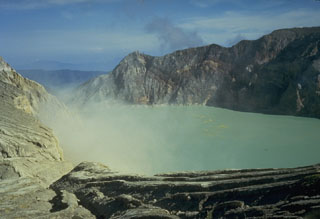Report on Ijen (Indonesia) — 21 March-27 March 2018
Smithsonian Institution / US Geological Survey
Weekly Volcanic Activity Report, 21 March-27 March 2018
Managing Editor: Sally Sennert.
Please cite this report as:
Global Volcanism Program, 2018. Report on Ijen (Indonesia) (Sennert, S, ed.). Weekly Volcanic Activity Report, 21 March-27 March 2018. Smithsonian Institution and US Geological Survey.
Ijen
Indonesia
8.058°S, 114.242°E; summit elev. 2769 m
All times are local (unless otherwise noted)
Based on information from residents of Sempol (8 km W), PVMBG reported that 27 people in Watu Capil village (7 km NW) required medical treatment after exposure to sulfur dioxide gas from Ijen at 2100 on 21 March. The path from Paltuding (SW base) to the top of the crater was closed as a result. During 21-22 March white plumes rose 100-200 m above the summit area; there were no visible changes in the emissions after the incident. PVMBG noted that there had been three occurrences of anomalous gas concentrations during January-March. The Alert Level remained at 1 (on a scale of 1-4), and residents and visitors were advised to not approach the crater rim or crater floor.
Geological Summary. The Ijen volcano complex at the eastern end of Java consists of a group of small stratovolcanoes constructed within the 20-km-wide Ijen (Kendeng) caldera. The north caldera wall forms a prominent arcuate ridge, but elsewhere the rim was buried by post-caldera volcanoes, including Gunung Merapi, which forms the high point of the complex. Immediately west of the Gunung Merapi stratovolcano is the historically active Kawah Ijen crater, which contains a nearly 1-km-wide, turquoise-colored, acid lake. Kawah Ijen is the site of a labor-intensive mining operation in which baskets of sulfur are hand-carried from the crater floor. Many other post-caldera cones and craters are located within the caldera or along its rim. The largest concentration of cones forms an E-W zone across the southern side of the caldera. Coffee plantations cover much of the caldera floor; nearby waterfalls and hot springs are tourist destinations.
Source: Pusat Vulkanologi dan Mitigasi Bencana Geologi (PVMBG, also known as CVGHM)

